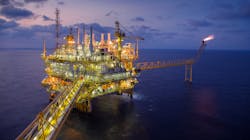Report: UK North Sea emissions higher
Offshore staff
LONDON — Greenhouse-gas (GHG) intensity from production in the UK and Norwegian averaged 12 kg CO2e/boe in 2022, according to S&P Global Commodity Insights.
Close to two-thirds of the overall production was found to have an intensity below that of the basinwide average. But certain other facilities accounting for 20% of total production generated half of the basin’s total GHG emissions.
S&P’s analysis found wide variability, ranging in GHG intensity from less than 1 kg CO2e/boe to nearly 150 kg CO2e/boe, with this range consistent across all the regions explored to date.
Findings were based on proprietary upstream databases and emerging sources such as reported emissions and satellite flaring data from the Earth Observation Group.
For more mature GHG-intensive fields, there may also be a need for energy-intensive enhanced recovery techniques and increased drilling to maintain productivity. And older technology can further exacerbate emissions intensity.
Other factors influencing GHG output include the degree to which operations can be electrified and the amount of venting and flaring.
“The scale and complexity of operations across the North Sea—a complex network of offshore platforms, drilling operations, subsea recovery units and pipelines—demonstrate how myriad factors influence the greenhouse gas intensity of any one asset,” said Christopher Kennett, associate director, S&P Global Commodity Insights. “
The analysis found that, on average, UK production in the North Sea was nearly three times more GHG-intensive (23 kg CO2e/boe) than Norwegian production (8 kg CO2e/boe).
Norwegian operations were advantaged as fields in the sector are typically less mature and with a greater percentage of output from larger, more productive, technologically advanced operations. In addition, Norwegian operations benefit from electrification supplied through subsea cables from Norway’s relatively low-emission, hydro-dominated power grid.
UK North Sea output tends to come from smaller, more mature or more geologically challenging fields, and others with older infrastructure and technology, leading to lower productivity and higher GHG intensity.
The analysis also found wider occurrence of flaring in UK offshore operations, with flaring and venting accounting for 28% of total UK North Sea emissions compared to 9% for Norway, with no benefit from electrification projects (as in Norwegian waters) to offset emissions from fuel combustion.
12.01.2022
